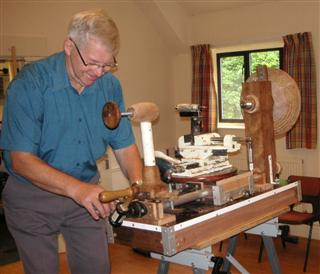Greg Morton was our demonstrator for the February meeting. His style brings out the teacher in him and he took his time explaining what he was doing with each step he took which was very helpful to those of us who are new to turning.
Gregís first piece of the day was a natural edge long bowl made from half a log of laburnum. Generally these are started on a screw chuck but Greg likes to set the log between centres, taking his time to get it running true both longitudinally and laterally. This ensures that the ends and sides are both the same height from the base on the finished bowl. Because this was made using wet wood he only roughed turned it and will leave it to dry out before finishing it. The shape means that the bowl will dry out at a quicker rate in the middle than at the ends so he marked where he will apply wax at the ends to allow the drying to be approximately the same rate throughout.
His second piece was an off centre vase designed to represent an arum lily. The log for this was a piece of yew and was cut at an angle at both ends and mounted between centres very close to the outside edge.
Once you are happy that it is securely fixed, pick up the biggest roughing gouge you can find and churn big fat shavings off it while it is still there!!
Finish off a little more gently with a spindle gouge to form a spigot on the bottom that will fit in to your chuck. Now reverse the piece and hold it in the chuck and shape in to the top and then use your gouge to bore the hole down the centre, removing it now and again to clear the flute. Next, bring the tail stock back into use and refine the shape of the top and then slim down the stem towards the base. Finally shape the base and part it off leaving just a small pip to remove by hand. With a bit of luck and a following wind it will end up looking like this. Well, almost. You will have polished yours to a fabulous finish. Wonít you.
The last item of the day was a table lamp to be made from banksia nuts, big ones. The shape was a standard practice of spindle turning. The two halves were joined by a spigot and socket (mortice and tenon) being glued together. One tip here is to cut an undercut at the base of the spigot so that the glue can run up it rather than come outwards and mark the finish of the spindle. The hollowing was done using a deep hole boring tool running through a hollow revolving tail stock centre. The base was turned from a piece of jarrah
The next Saturday meeting on March 10th will be a demonstration by Dennis Keeling which should be one to see
Graham
Notice board
Sadly, we learnt that Ernie Frith passed away in the afternoon on Saturday 11th February. He had been a member of the club for many years and when he finally gave up turning he donated several books and DVDís to the club with which we started our library for the benefit of the members.

Ernie Frith |
|


